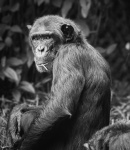 From ScienceDaily:
From ScienceDaily:
It’s very difficult to determine when, how and why human language began. While fossil primates provide important clues about human evolution, the sounds they made and the soft tissue involved in making those sounds weren’t preserved.
But chimpanzees — one of our closest living relatives — provide important points of comparison for inferring the sorts of sounds our early ancestors may have made. During the 175th Meeting of the Acoustical Society of America, being held May 7-11, 2018, in Minneapolis, Minnesota, Michael Wilson, an associate professor at the University of Minnesota, will present his group’s work searching for similarities between the vocal communications of chimpanzees and humans.
“Chimpanzees give a range of different calls: hoots, pant-hoots, pant-grunts, pant-barks, rough-grunts, nest-grunts, alarm barks, waa-barks, wraas, screams, copulation screams, and soft panting play sounds (a.k.a. laughter),” Wilson said. “Many of these calls grade into one another, and it can be difficult to categorize particular examples of some calls.”
Doubtless. One finds the same with cats, with the additional complication that the feline body is widely used for communication, complementing or replacing sounds.*
The group’s findings so far suggest that chimpanzee vocalizations resemble human language less than you’d expect. For example, Wilson’s student Lisa O’Bryan studied food-associated rough-grunt calls at Gombe and in a group of captive chimpanzees in Texas. “In contrast to some previous studies, which reported that rough-grunts vary acoustically in ways that could inform other chimpanzees about food quality, she found that within rough-grunt sequences to a given food type, chimpanzees produce a range of rough-grunt variants — suggesting there is no consistent match between acoustic features and food quality,” Wilson said.
And, it turns out, “chimpanzee vocal communication isn’t particularly language-like,” Wilson said. “This is surprising, given that chimpanzees resemble us in so many other ways. But it seems that the key events in language evolution occurred well after the divergence of the chimpanzee and hominin (primate) lineages. In this case, language likely evolved due to uniquely human circumstances.” More.
So, in short, no, chimp sounds will not be much help in understanding human language, however it evolved. What no on wants to confront is that human language involves concepts that have no equivalent in the animal world, which includes the chimp world, though some of the most amazing mental gymnastics are offered, to try to efface that fact.**
No paper is mentioned. The materials were provided by the Acoustical Society of America. Perhaps, given that these people are technicians, they are less likely to front nonsense to the public than academics would.
File under: Flight from reality
* That tendency may relate to the cat’s ecological status as a small predator who is also prey. He must weigh the value of creating noise against the risks of doing so. For example, cats often use assertive or aggressive staring as a form of communication. The message can be sent to the party of interest while the cat himself remains motionless and soundless, and not obviously committed to any particular action.
** See also: PBS: Apes’ inability to use symbolic language may just be “nurture”
Are IQ tests “unfair” to apes?
Are apes entering the Stone Age?
Note: Give to the conservation cause, sure, but be skeptical of the claims.